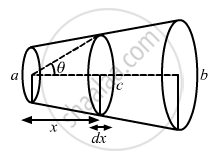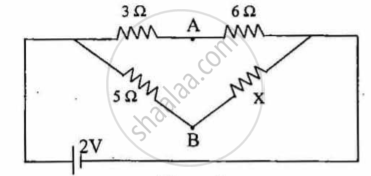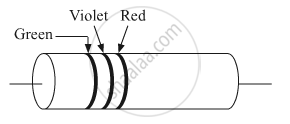Advertisements
Advertisements
Question
The following figure shows a conductor of length l with a circular cross-section. The radius of the cross-section varies linearly from a to b. The resistivity of the material is ρ. Assuming that b – a << l, find the resistance of the conductor.

Solution
Let us consider a small element strip of length dx at a distance x from one end, as shown below.

Let the resistance of the small element strip be dR. Let the radius at that point be c .
Then, the resistance of this small strip,
\[dR = \frac{\rho dx}{\pi c^2} .............(1)\]
\[\tan\theta = \frac{c - a}{x} = \frac{b - a}{L}\]
\[ \Rightarrow \frac{c - a}{x} = \frac{b - a}{L}\]
\[ \Rightarrow L \times \left( c - a \right) = x \times \left( b - a \right)\]
\[ \Rightarrow Lc - La = xb - xa\]
Differentiating w.r.t to x, we get:-
\[L\frac{dc}{dx} - 0 = b - a \]
\[ dx = \frac{Ldc}{\left( b - a \right)} ...........(2)\]
Substituting the value of dx in equation (1), we get:-
\[dR = \frac{\rho Ldc}{\pi c^2 \left( b - a \right)}\]
\[dR = \frac{\rho L}{\pi\left( b - a \right)} \cdot \frac{dc}{c^2}\]
Integrating dR from a to b, we get:-
\[\int_0^R dR = \frac{\rho L}{\pi\left( b - a \right)} \int_a^b \frac{dc}{c^2}\]
\[ \Rightarrow R = \frac{\rho L}{\pi\left( b - a \right)} \left[ \frac{- 1}{c} \right]_a^b \]
\[ = \frac{\rho L}{\pi\left( b - a \right)}\left( \frac{- 1}{b} - \frac{- 1}{a} \right)\]
\[ = \frac{\rho L}{\pi ab}\]
APPEARS IN
RELATED QUESTIONS
Show variation of resistivity of copper as a function of temperature in a graph.
Define the term 'conductivity' of a metallic wire. Write its SI unit.
Using the concept of free electrons in a conductor, derive the expression for the conductivity of a wire in terms of number density and relaxation time. Hence obtain the relation between current density and the applied electric field E.
Define current density. Write an expression which connects current density with drift speed
Define the term 'electrical conductivity' of a metallic wire. Write its S.I. unit.
The heat developed in a system is proportional to the current through it.
The specification on a heater coil is 250 V, 500 W. Calculate the resistance of the coil. What will be the resistance of a coil of 1000 W to operate at the same voltage?
For a metallic conductor, what is the relation between current density (J), conductivity (σ) and electric field intensity (E)?
In Figure 3 given below, find the value of resistance x for which points A and B are at the same potential:

figure 3
A carbon resistor is shown in the figure. Using color code, write the value of the resistance.

Assertion: Bending a wire does not effect electrical resistance.
Reason: Resistance of wire is proportional to resistivity of material.
The electric resistance of a certain wire of iron is R. If its length and radius are both doubled, then ______.
A constant voltage is applied between the two ends of a uniform metallic wire, heat ‘H’ is developed in it. If another wire of the same material, double the radius and twice the length as compared to the original wire is used then the heat developed in it will be -
A man covers his body with a blanket of thickness 4 mm. His temperature is 37°C and that of the atmosphere is 27°C. If the coefficient of thermal conductivity of wool is 1.2 × 10-5 MKS units, heat lost by him per hour per square meter area is:
The resistivity of a wire ______
